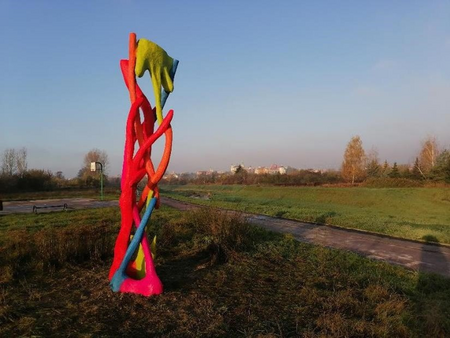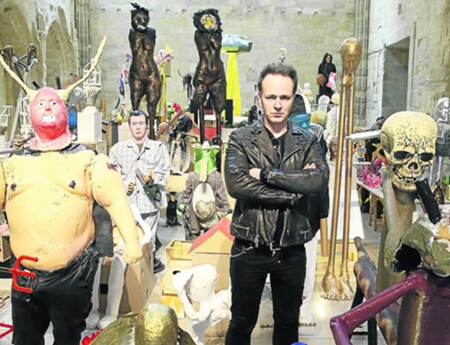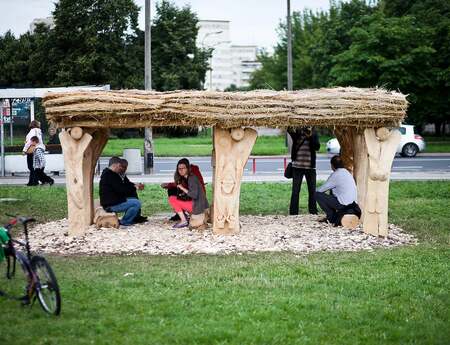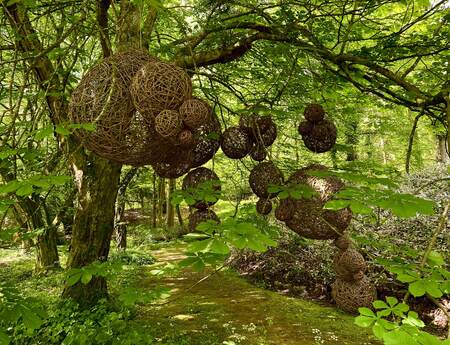The Heresy of Kristof (part two): When sculpture turns to be a graph in a group dynamics study
Krzysztof Krzysztof (b. 1980, lives in Krakow, PL) is interested in the response on public sculptures in areas of conflict. After researching the destruction of Soviet monuments in Poland in post-communist times, he moved to Belfast, Northern Ireland. His research consist of an impressive theoretical study, as well as a practical part, creating sculptures to test the public response.
Response to art in public space
What is denial? It’s a pathological defense mechanism, a reaction of the mind to remain unconscious of an experience that you cannot accept. Otherwise it would damage your mental state.
While researching the group dynamic in the response on public sculpture, I became interested in neurotic defense mechanisms, such as displacement or intellectualization.
In 2014, I started my journey at Ulster University in Belfast, Northern-Ireland as a fresh Ph.D. researcher. Using Kurt Lewin's theory on group dynamics as a starting point, my goal was to research attitudes toward contemporary sculpture in public space. Was there a testable group reaction on an art object that was recognized as a representation of a specific group?
Peace Thru Arts Programme
In this context, Northern Ireland could be a fascinating case study. After the Good Friday Agreement brought peace in 1998, the Peace Thru Arts Programme fostered contemporary sculpture in public space. It was the flagship of the Northern Ireland Arts Council.
While murals had served as a battleground for conflicted communities, contemporary sculpture was not tainted by the past. Apart from Anthony Gormley's double figure Derry Walls (1987), there was hardly any sculpture in public space. Not being linked to the Troubles era, the medium of sculpture could become a natural sign for the better tomorrow.
Interdisciplinary approach
My job was to critically look at the process of working attitudes among the local population toward art. I chose for an interdisciplinary approach, working as a researcher in practice (a sculptor) and a psychological theorist. Probably the most hated connection.
The very first issue which came to my mind, during the first months of research on literature sources was a division between the language used in criticism of modern contemporary sculpture from the point of philosophy of aesthetics, and the psychology of depth. What worried me was that terms like ‘object’, impact’, ‘force’ were being used by the first avantgarde as well as in Freudian observations.
Another division that hit me at that stage, was the devastating role of the Cold War in the dislocation of meaning and purpose for sculpture in public spaces in the global West and the Soviet Block in the past. How many chances, talents, and possibilities were lost? Will we ever be able to build solid bridges above once conflicted territories?
ATAQ Attitude Toward Art Questionnaire
The outcome of my research was the method called Attitude Toward Art Questionnaire (ATAQ). It evolved from my experiments with existing contemporary sculptures placed in Northern Ireland and Poland. In 2015 and 2016, I created two artworks, that were used in the experiments as well.
What does ATAQ do? The test consists of five questions to people who had contact with the observed artwork.
ATAQ helps us to perceive the response to the artwork as the outcome of a group dynamic. The artwork functions as a projection space for emotions, and reveals possible defense mechanisms of people.
With that method, there is no good or bad sculpture. There is no like or dislike. With ATAQ, the artwork, or specific sculpture is no longer a commodity nor a personal aesthetical judgment. It becomes a multi-logical sphere of human relations related to the history of the place, with a visible sketch for the future reactions.
If you like to read the thesis, you will find it in the domain of Ulster University online library under the title: Attitude Towards Public Sculpture as a Group Dynamic Process: Adaptation of the Kurt Lewin’s force field concept into art theory. However, that is not the end of the story.
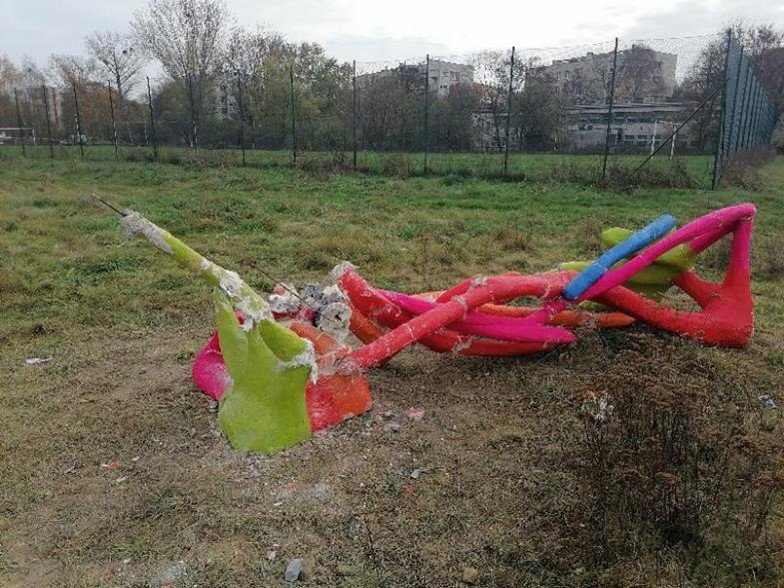
Skin
June 2020, the Cultural Society for Education in Lubin, PL (Towarzystwo Edukacji Kulturalnej w Lublinie) invited me to produce a sculpture for a public space, which I gladly accepted. After five months of work, I exhibited a sculpture called Skin, an abstract, rainbow-like colored object. On the day the work was installed, I used the ATAQ method to get feedback from the public.
Skin survived just for two days. It was thrown down, broken, and twisted by a group of post-fascist Christians (they left a note informing about their ideology, so there can’t be any doubt about the prepatrators).
After the artwork was damaged, I made another experiment with ATAQ. When reading the answers of the survey, what struck me was the attitude of denial exposed in the second experiment. The people who were looking at the destroyed sculpture were unable to verbalize the problem. Neither could they mention it a destroyed artwork, or link it to the area they live in.
This could mean that the devastation of Skin and its Pride flag-related colors hit them deeply. Or, when the context of local conflicts is taken into consideration, it could mean that they were unable to protect the artwork against the aggressors.
Sculpture as a work of art is not designed with the aim of stopping the conflict which is hanging in the air. As an artist, I was shocked by what happened to Skin and the agression towards the local LHTB-community it referred to. However, as a scientist, I discovered a link between denial and aggression toward public art. Perhaps, if I will be able to continue my experiments from that interdisciplinary field, I will be able to find more answers on that issue. Currently, I focus on my work as an artist again.
Krzysztof Krzysztof, Attitude Towards Public Sculpture as a Group Dynamic Process: Adaptation of the Kurt Lewin’s force field concept into art theory. University of Ulster, 2017 https://core.ac.uk/download/pdf/287024705.pdf
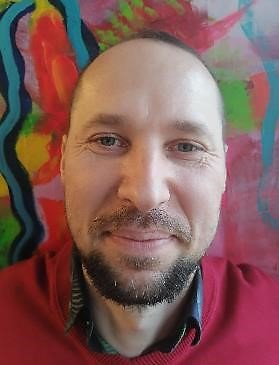
Author: Dr. Krzysztof Krzysztof (artist name Kristof) worked as a researcher and lecturer at the University of Ulster, Ireland, and The Ignatianum Academy, Institute of Psychology in Krakow, Poland. Currently, he as active as an artist. You may like his page at @KrzysztofStudio or visit his page at Krzysztof.mozello.com
Cover picture: Krzysztof Krzysztof, Skin, 2020, Lublin, PL, commissioned by the Cultural Society for Education
